| How about Women of the west
Annie Oakley from Wikipedia
| Annie Oakley (August 13, 1860 – November 3, 1926), born
Phoebe Ann Moses, was an American sharpshooter and exhibition shooter.
Oakley's amazing talent and timely rise to fame led to a starring role
in Buffalo Bill's Wild West show, which propelled her to become the first
American female superstar.
Oakley's perhaps most famous trick is being able to repeatedly
split a playing card, edge-on, and put several more holes in it before
it could touch the ground, while using a .22 caliber rifle, at 90 feet.
Early life
Phoebe Ann (Annie) Moses was born in "a cabin less than
two miles northwest of Willowdell in Partentown North Star, Ohio", a rural
western border county of Ohio. Her birthplace log cabin site is about five
miles eastward of North Star. There is a stone-mounted plaque in the vicinity
of the cabin site, which was placed by the Annie Oakley Committee in 1981,
121 years after her birth.
Annie's parents were Quakers of English descent from Hollidaysburg,
Blair County, Pennsylvania: Susan Wise, age 18, and Jacob Moses (1860 U.S.
Census shows his father's name as Mauzy, born 1799), age 49, married in
1848. They moved to a rented farm (later purchased with a mortgage) in
Patterson Township, Darke County. The move occurred sometime around 1855.
Her sister Sarah Ellen was born in Darke County in 1857.
Born in 1860, Annie was the sixth of Jacob and Susan's
seven children. Her father, who had fought in the War of 1812, died in
1866 at age 65, from pneumonia and overexposure in freezing weather. Her
mother married Daniel Brumbaugh, had one more child, Emily, and was widowed
for the second time.
On March 15, 1870, at age nine, Annie was admitted to
Darke County Infirmary, along with elder sister Sarah Ellen. According
to her autobiography, she was put in the care of the Infirmary's superintendent,
Samuel Crawford Edington and his wife Nancy, who taught her to sew and
decorate. Beginning in the spring of 1870, she was "bound out" to a local
family to help care for their infant son, on the false promise of fifty
cents a week and an education. She spent about |
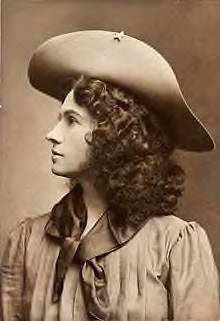
| Born |
Phoebe Ann Moses
August 13, 1860
North Star, Ohio, United States |
| Died |
November 3, 1926 (aged 66)
Greenville, Ohio |
| Spouse(s ) |
Frank E. Butler (1850–1926)
(m. 1882–1926) |
| Parents |
Susan Wise (Moses) (1830–1908),
Jacob Moses (1799–1866 |
| Signature |
 |
|
two years in near-slavery to them where she endured mental
and physical abuse. She would often have to do boys' work. One time the
wife put Annie out in the freezing cold, without shoes, as a punishment
because she had fallen asleep over some darning. Annie referred to them
as "the wolves". Even in her autobiography, she kindly never told the couple's
real name. When, in the spring of 1872, she reunited with her family, her
mother had married a third time, to Joseph Shaw.
Because of poverty following the death of her father,
Annie did not regularly attend school. But later, she did receive some
additional education. She rendered her surname as ending in "ee", while
it appears as "Moses" on her father's gravestone and in his military record;
it is the official spelling by the Annie Oakley Foundation maintained by
her living relatives. Variations in the accepted surname spelling ("Moses")
have included "Mosey", "Mosie", and "Mauzy". There is no known record to
substantiate Annie's vehement assertion that the correct spelling is "Mozee".
Annie began trapping at a young age, and shooting and
hunting by age eight to support her siblings and her widowed mother. She
sold the hunted game for money to locals in Greenville, as well as restaurants
and hotels in southern Ohio. Her skill eventually paid off the mortgage
on her mother's farm when Annie was 15.
Debut and marriage
| Annie soon became well known throughout the region. On
Thanksgiving Day 1875, the Baughman and Butler shooting act was being performed
in Cincinnati.
Traveling show marksman and former dog trainer Francis
E. Butler (1850–1926), an Irish immigrant, placed a $100 bet per side (worth
$2,091 today) with Cincinnati hotel owner Jack Frost, that he, Butler,
could beat any local fancy shooter. The hotelier arranged a shooting match
between Butler and the 15-year-old Annie saying, "The last opponent Butler
expected was a five-foot-tall 15-year old girl named Annie." After missing
on his 25th shot, Butler lost the match and the bet. He soon began courting
Annie, and they married on August 23, 1876. They did not have children.
Career and touring
| Aim at the high mark and you will hit it. No, not the
first time, not the second time and maybe not the third. But keep on aiming
and keep on shooting for only practice will make you perfect. Finally you'll
hit the bull's-eye of success.
— Annie Oakley , Annie Oakley exhibit
at the National Cowgirl Museum and Hall of
.........................................................................................................Fame
in Fort Worth, Texas |
|
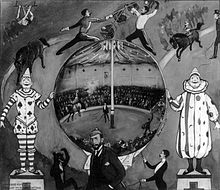
Annie Oakley performing at an amateur
circus in Nutley, New Jersey, in
1894,
to raise funds for the Red Cross |
Annie and Frank Butler lived in Cincinnati, for a time. Oakley,
the stage name she adopted when she and Frank began performing together,
is believed to have been taken from the city's neighborhood of Oakley,
where they resided. Some people believe she took on the name because that
was the name of the man who had paid her train fare when she was a child.
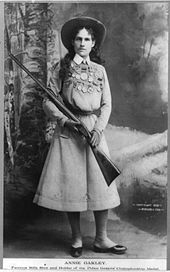 . .
Oakley circa 1899 |
They joined Buffalo Bill's Wild West Show in 1885. At
5 feet (1.5 m) tall, Oakley was given the nickname of "Watanya Cicilla"
by fellow performer Sitting Bull, rendered "Little Sure Shot" in the public
advertisements.
During her first engagement with Buffalo Bill's show,
Oakley experienced a tense professional rivalry with rifle sharpshooter
Lillian Smith. Being eleven years younger, Smith promoted herself as younger
and therefore more billable than Oakley. Oakley temporarily left the Buffalo
Bill's show but returned after Smith departed.
In Europe, she performed for Queen Victoria of the United
Kingdom, King Umberto I of Italy, Marie François Sadi Carnot (the
President of France) and other crowned heads of state. Oakley had such
good aim that, at his request, she knocked the ashes off a cigarette held
by the newly crowned German Kaiser Wilhelm II.
The Annie Oakley Foundation suggests that she was not
the source of a widely repeated quip related to the event: "Some uncharitable
people later ventured that if Annie had shot Wilhelm and not his cigarette,
she could have prevented World War I." After the outbreak of World War
I, however, Oakley did send a letter to the Kaiser, requesting a second
shot. The Kaiser did not respond.
Oakley promoted the service of women in combat operations
for the United States armed forces. She wrote a letter to President William
McKinley on April 5, 1898, "offering the government the services of a company
of 50 'lady sharpshooters' who would provide their own arms and ammunition
should the U.S. go to war with Spain. |
.
| The Spanish-American War did occur, but Oakley's offer
was not accepted. Theodore Roosevelt, did, however, name his volunteer
cavalry the "Rough Riders" after the "Buffalo Bill's Wild West and Congress
of Rough Riders of the World" where Oakley was a major star.
Based on a story that ran in The Athens Messenger, and
just before Oakley's train accident during a Wild Bill show held at the
Athens County Fairgrounds in Athens, Ohio, in 1901, a 9-year-old girl named
Ethel Bell Nice, known around the local community for her shooting prowess,
was prodded into a shooting contest with Annie and won. Ethel went on to
marry Thomas Gilbraith and later taught soldiers stationed at her husband's
military base how to use firearms.
The same year that McKinley was fatally shot by an assassin,
1901, Oakley was also badly injured in a train accident, but she recovered
after temporary paralysis and five spinal operations. She left the Buffalo
Bill show and in 1902 began a quieter acting career in a stage play written
especially for her, The Western Girl. Oakley played the role of Nancy Berry
and used a pistol, a rifle and rope to outsmart a group of outlaws.
Following her injury and change of career, it only added
to her legend that her shooting expertise continued to increase into her
60s.
Throughout her career, it is believed that Oakley taught
upwards of 15,000 women how to use a gun. Oakley believed strongly that
it was crucial for women to learn how to use a gun, as not only a form
of physical |
.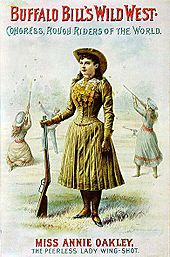
Wild West show poster |
and mental exercise, but also to defend themselves. She said:
"I would like to see every woman know how to handle [firearms] as naturally
as they know how to handle babies."
Libel cases
In 1904, sensational cocaine prohibition stories were
selling well. The newspaper magnate William Randolph Hearst published a
false story that Oakley had been arrested for stealing to support a cocaine
habit. The woman actually arrested was a burlesque performer who told Chicago
police that her name was "Annie Oakley". The original Annie Oakley spent
much of the next six years winning 54 of 55 libel lawsuits against newspapers.
She collected less in judgments than were her legal expenses, but to her,
a restored reputation justified the loss of time and money.
Most of the newspapers that printed the story had relied
on the Hearst article, and upon learning of the libelous error they immediately
retracted the false story with apologies. Hearst, however, tried to avoid
paying the anticipated court judgments of $20,000 ($300,000, adjusted for
inflation in 2008 dollars) by sending an investigator to Darke County with
the intent of collecting reputation-smearing gossip from Oakley's past.
The investigator found nothing.
Later years and death
| Oakley continued to set records into her sixties, and
she also engaged in extensive, albeit quiet, philanthropy for women's rights
and other causes, including the support of specific young women that she
knew. She embarked on a comeback and intended to star in a feature-length
silent movie. In a 1922 shooting contest in Pinehurst, North Carolina,
sixty-two-year-old Oakley hit 100 clay targets in a row from 16 yards (15
m).
In late 1922, Oakley and Butler suffered a debilitating
automobile accident that forced her to wear a steel brace on her right
leg. Yet after a year and a half of recovery, she again performed and set
records in 1924.
Her health declined in 1925 and she died of pernicious
anemia in Greenville, Ohio at the age of sixty-six on November 3, 1926.
She was buried in Brock Cemetery in Greenville, Ohio. Butler was so grieved
by her death that he stopped eating. He died just 18 days later, on November
21, 1926 in Michigan. Butler was buried next to Annie.
After her death, her incomplete autobiography was given
to Fred Stone, the stage comedian, and it was discovered that her entire
fortune had been spent on her family and her charities.
She was inducted into the National Cowgirl Museum and
Hall of Fame in Fort Worth, Texas.
The Little Sure Shot of the Wild West
|
.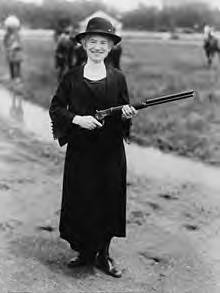
Oakley in 1922 |
When Buffalo Bill performed, he decided to hire someone else
instead of Annie. In 1894 Oakley and Butler performed in Edison's Kinetoscope
film, The "Little Sure Shot" of the "Wild West," an exhibition of rifle
shooting at glass balls, etc. Filmed November 1, 1894, in Edison's Black
Maria studio by William Heise (0:21 at 30 frame/s; 39 ft.), it was about
the 11th film made after commercial showings began on April 14, 1894.
Oakley's early movie star opportunity followed from Buffalo
Bill's friendship with Thomas Edison, which developed after Edison personally
built, for the Wild West Show, what in the 1890s was the world's largest
electrical power plant. Buffalo Bill and fifteen of his show Indians appeared
in two Kinetoscopes filmed September 24, 1894.
Eponym
During her lifetime, the theatre business began referring
to complimentary tickets as "Annie Oakleys". Such tickets traditionally
have holes punched into them (to prevent them from being resold), reminiscent
of the playing cards Oakley shot through during her sharpshooting act.
Representations on stage, literature and screen
- In 1935, Barbara Stanwyck played Oakley
in a fictionalized film called Annie Oakley.
- The 1946 Broadway musical Annie Get Your
Gun is loosely based on her life. The original stage production starred
Ethel Merman, who
also starred in
the 1966 revival. A 1950 film version starred Betty Hutton. Some years
after headlining the 1948 national tour, Mary Martin
returned to the
role for a 1957 NBC television special.
- From 1954 to 1956, Gail Davis played Oakley
in the Annie Oakley television series.
- A fictionalized Oakley appeared in the
1966 comedy film Carry On Cowboy. Oakley was played by Angela Douglas.
- In 1976, Geraldine Chaplin played Oakley
in Buffalo Bill and the Indians with John Considine as Frank Butler.
- In 1982, Diane Civita played Oakley, opposite
Richard Donner as Bill Cody, in an episode of Voyagers!, where, during
Cody's
performances for
Queen Victoria, Oakley engaged in a marksmanship contest with a Russian
duke.
- In 1982, the British rock band Squeeze
released a song called "Annie Get Your Gun".
- In 1985, Jamie Lee Curtis portrayed her
in the "Annie Oakley" episode of the children's video series Shelley Duvall's
Tall Tales and
Legends.
- In 1996, Reba McEntire portrayed Annie
in Buffalo Girls alongside Anjelica Huston, Melanie Griffith and Tom Wopat.
- In 1998, A Shooting Star: A Novel About
Annie Oakley by Sheila Solomon Klass was republished.
- In 1999, Annie Get Your Gun was revived
on Broadway with Bernadette Peters in the title role. Susan Lucci assumed
the role when Peters
took a vacation
from the show, Cheryl Ladd assumed the role from Peters and was followed
by Reba McEntire and Crystal Bernard.
- In 2004, Elizabeth Berridge played Annie
Oakley in the Touchstone Pictures film Hidalgo.
- In 2006, an episode of PBS's American
Experience documented Oakley's life.
- In 2009, the band Watchout! There's Ghosts
released a song called "Don't Shoot Me, Annie Oakley".
- In 2010, The Geraghtys released a song
titled "Annie Oakley", that references the famous sharpshooter.
|
| Lucille Mulhall from Wikipedia
Lucille Mulhall (October 21, 1885 – December 21, 1940)
was a well known cowgirl and Wild West performer.
| Early years
She was born in St. Louis, Missouri to Zach and Agnes
Mulhall. Her parents brought her to Oklahoma Territory in 1889. She was
raised on her family's Mulhall Ranch in Oklahoma Territory, near what is
now Mulhall, Oklahoma.
Career as a performer
Known as one of the first women to compete with men in
roping and riding events, she was called Rodeo Queen, Queen of the Western
Prairie, and Queen of the Saddle (among many other appellations). She starred
in the Miller Brothers' 101 Ranch Wild West Show, formed her own troupe
in 1913 and performed in many rodeo and Wild West shows throughout her
career. She |
.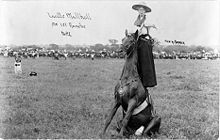
Lucille Mulhall, standing the back
of a seated horse |
produced her own rodeo in 1916. She retired to her family's
ranch in Mulhall around 1922.
Death
Mulhall died in Logan County, Oklahoma, in an automobile
accident less than a mile from the Mulhall Ranch.
|
| Mollie Monroe from Wikipedia
Mary E. Sawyer (1846-1902), better known as Mollie Monroe,
was an American old west woman who was known for crossdressing and for
her liaisons with multiple men, among other things.
Monroe fell in love with a man as a teenager. Both her
family and her boyfriend's family agreed that the couple was too young
to marry, and the man was sent away.
Monroe then decided to go after her boyfriend, disguised
as a man and calling herself Sam Brewer. Her search ended in sadness, when
she discovered her boyfriend had been murdered by a gang during a bar brawl.
Monroe then swore to avenge his death, crossing virtually
every city from Utah to northern Mexico. She failed to find her boyfriend's
killers, and became an alcoholic.
Around 1870, she met George Monroe, a well known and rich
miner. Mollie and George Monroe married and settled in Wickenburg, Arizona,
where they mined together. In 1874, they moved to Prescott, Arizona. George
Monroe had discovered a water spring there. He turned it into a resort
and named it "Monroe Springs". The attraction drove many tourists from
around the country.
Mollie Monroe was also a gambler. Apart from her alcoholism,
her gambling addiction also led her to lose a considerable amount of money,
once selling a gold mine she had discovered for around $2,500 dollars,
then gambling the money away in about a week.
Despite her addictions, Monroe enjoyed helping needy people,
such as prostitutes, lone women and their children. Legend has it that
once she met a woman and her children; having been told by the woman that
her husband went to town for supplies three days before and had not returned,
she went searching for the man, and found him in a bar. She then led him
out of the bar, tied him to her horse and dragged him all the way back
to his house, staying overnight to make sure he wouldn't leave the house
again.
A newspaper report also told of her saving the lives of
20 army men when attacked by Apaches. According to the article, she had
left the men to look for items to cook with, and when she returned, she
noticed that the army men were surrounded by Apache, and that two army
men had already been killed. She and her friend, Texas Johnson, fired shots
into the air, and the Apaches ran, according to the news.
Mollie Monroe was despised by most of Prescott's high
society women, for what they viewed as "manly manners" and, as a popular
publication of the time said, "morals that are dissolute".
In 1877, she was found wandering across the streets of
Peeples Valley by a policeman named Ed Bowers. Brought to trial, she was
found to be insane on May 9 and sent to a sanitarium in Stockton, California.
Along the way to Stockton, she and Bowers were attacked
by thieves. Other than Bowers losing a watch and some 450 dollars, the
lawman and Monroe came out unscathed from the attack.
Mollie Monroe's times at the California asylum did not
go without controversy: she tried burning the building once, causing her
to be sent to San Quentin jail. Once there, she forged a friendship with
former Arizona governor A.P.K. Safford (after whom the city of Safford,
Arizona is named). Many viewed this as an attempt by Mollie to get out
of San Quentin.
In 1887, she was sent to a new asylum built in Phoenix.
In 1895, she escaped the asylum, and was found four days later. With only
a few crackers and a bottle of water taken to support herself, she was
found bleeding and in bad overall health.
Her health, troubled by her alcohol problems, continued
to decline, and in 1902, she died in the Phoenix asylum.
|
| Belle Starr from Wikipedia
Myra Maybelle Shirley Reed Starr (February 5, 1848 – February
3, 1889), better known as Belle Starr, was a notorious American outlaw.
| Early life
Belle Starr was born as Myra Maybelle Shirley on her father's
farm near Carthage, Missouri. She was known as May to her family. Her father
was John Shirley. Her mother, Eliza Hatfield, was related to the Hatfields
of the famous family feud. In the 1860s her father sold the farm and moved
the family to Carthage, where he bought an inn and livery stable on the
town square.
May Shirley received a classical education and learned
piano, while graduating from Missouri's Carthage Female Academy, a private
institution that her father had helped to found.
During the Civil War
After a Union attack on Carthage in 1864, the Shirleys
moved to Scyene, Texas. According to legend, it was at Scyene that the
Shirleys became associated with a number of Missouri-born criminals, including
Jesse James and the Youngers. In fact, she knew the Younger brothers and
the James boys because she had grown up with them in Missouri. Her brother,
John A. M. "Bud" Shirley, was called Captain Shirley by local Confederate
sympathizers. He does not appear on any list of Quantrill's Raiders, but
rode with a group who were called partisans by some and bushwackers by
Union sympathizers. Bud Shirley was killed in 1864 in Sarcoxie, Missouri,
while he and another scout were being fed at the home of a Confederate
sympathizer. Union troops surrounded the house and when Bud attempted to
escape, he was shot and killed.
After the Civil War
Following the war, the Reed family also moved to Scyene
and May Shirley married Jim Reed in 1866, after having had an earlier crush
on him as a teen. Two years later, she gave birth to her first child, Rosie
Lee (nicknamed Pearl). Belle always harbored a strong sense of style, which
would feed into her later legend. A crack shot, she used to ride sidesaddle
while dressed in a black velvet riding habit and a plumed hat, carrying
two pistols, with cartridge belts across her hips. Jim turned to crime
and was wanted for murder in Arkansas, which caused the family to move
to California, where their second child, James Edwin (Eddie), was born
in 1871.
Later returning to Texas, Jim Reed was involved with several
criminal gangs. While Jim initially tried his hand at farming, he would
grow restless and fell in with bad company—the Starr clan, a Cherokee Indian
family notorious for whiskey, cattle, and horse thievery in the Indian
Territory (now Oklahoma), as well as his wife's old friends the James and
Younger gangs. In April 1874, despite a lack of any evidence, a warrant
was issued for her arrest for a stagecoach robbery by her husband and others.
Jim Reed was killed in Paris, Texas, in August of that year, while he settled
down with his family.
Marriage to Sam Starr
Allegedly, Belle was briefly married for three weeks to
Cole Younger in 1878, but this is not substantiated by any evidence. In
1880 she did marry a Cherokee man named Sam Starr and settled with the
Starr family in the Indian Territory. There, she learned ways for organizing,
planning and fencing for the rustlers, horse thieves and bootleggers, as
well as harboring them from the law. Belle's illegal enterprises proved
lucrative enough for her to employ bribery to free her cohorts from the
law whenever they were caught.
In 1883, Belle and Sam were charged with horse theft and
tried before "The Hanging Judge" Isaac Parker's Federal District Court
in Fort Smith, Arkansas; the prosecutor was United States Attorney W. H.
H. Clayton. She was found guilty and served nine months at the Detroit
House of Corrections in Detroit, Michigan. Belle proved to be a model prisoner
and during her time in jail she won the respect of the prison matron, while
Sam was more incorrigible and was assigned to hard labor. |
.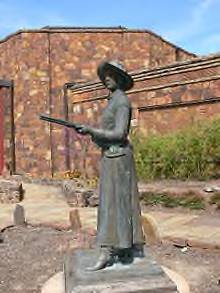
Statue of Belle Starr
Woolaroc, Oklahoma
| Born.. |
Myra Maybelle Shirley
February 5, 1848
Carthage, Missouri |
| Died |
February 3, 1889 (aged 40)
near King Creek, Indian Territory |
..
.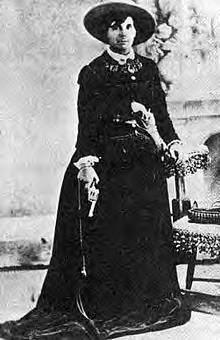
Studio portrait of Belle Starr
"Queen of the Oklahoma Outlaws"
circa early 1880s. |
In 1886, she escaped conviction on another theft charge,
but on December 17, Sam Starr was involved in a gunfight with Officer Frank
West. Both men were killed, while Belle's life as an outlaw queen—and what
had been the happiest relationship of her life—abruptly ended with her
husband's death.
Unsolved murder
For the last two-plus years of her life, gossips and scandal
sheets linked her to a series of men with colorful names, including Jack
Spaniard, Jim French and Blue Duck, after which, in order to keep her residence
on Indian land, she married a relative of Sam Starr, Jim July Starr, who
was some 15 years her junior.
On February 3, 1889, two days before her 41st birthday,
she was killed. She was riding home from a neighbor's house in Eufaula,
Oklahoma, when she was ambushed. After she fell off her horse, she was
shot again to make sure she was dead. Her death resulted from shotgun wounds
to the back and neck and in the shoulder and face.
There were no witnesses and no one was ever convicted
of the murder. Suspects with apparent motive included her new husband and
both of her children, as well as Edgar J. Watson, one of her sharecroppers,
because he was afraid she was going to turn him in to the authorities as
an escaped murderer from Florida with a price on his head. Watson, who
was killed in 1910, was tried for her murder, but was acquitted, and the
ambush has entered Western lore as "unsolved".
One source suggests her son, whom she had allegedly beaten
for mistreating her horse, may have been her killer.
Story becomes popularized
Although an obscure figure outside Texas throughout most
of her life, Belle's story was picked up by the dime novel and National
Police Gazette publisher, Richard K. Fox. Fox made her name famous with
his novel Bella Starr, the Bandit Queen, or the Female Jesse James, published
in 1889 (the year of her murder). This novel is still often cited as a
historical reference. It was the first of many popular stories that used
her name.
Children
Belle's son, Eddie Reed, was convicted of horse theft
and receiving stolen property in July 1889. Judge Parker sent him to prison
in Columbus, Ohio. Belle's daughter, Rosie Reed, also known as Pearl Starr,
became a prostitute to raise funds for Eddie's release. She did eventually
obtain a presidential pardon in 1893. Ironically, Eddie became a deputy
in Fort Smith and killed two outlaw brothers named Crittenden in 1895,
and was himself killed in a saloon in Claremore, Oklahoma on December 14,
1896.
Pearl operated several bordellos in Van Buren and Fort
Smith, Arkansas, from the 1890s to World War I.
|
.
All articles submitted to the "Brimstone
Gazette" are the property of the author, used with their expressed permission.
The Brimstone Pistoleros are not
responsible for any accidents which may occur from use of loading
data, firearms information, or recommendations published on the Brimstone
Pistoleros web site. |
|